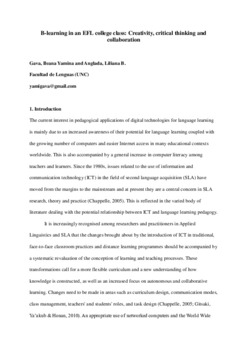| dc.contributor.author | Gava, Ileana Yamina | |
| dc.contributor.author | Anglada, Liliana Beatriz | |
| dc.date.accessioned | 2022-11-07T16:13:46Z | |
| dc.date.available | 2022-11-07T16:13:46Z | |
| dc.date.issued | 2015 | |
| dc.identifier.isbn | 978-987-45982-0-2 | |
| dc.identifier.uri | http://hdl.handle.net/11086/29434 | |
| dc.description.abstract | Research in educational technology is relatively new and the literature on the topic offers a variety of approaches. One of the most recent research trends aims at exploring and analyzing the phenomena that accompany the use of computers in the classroom. The focus of this trend is not only to shed light on meaningful and pedagogically innovative applications of ICT in various school and college settings, but also to develop more solid theoretical foundations for Web-based pedagogy (Area Moreira, 2005). In the field of foreign language pedagogy, socioconstructivist theories of learning have been highly influential, especially in the design and implementation of WBLL (Web-based Language Learning) environments (Levy & Stockwell, 2006). Within this framework, this paper analyses how WBLL was integrated in an EFL university class through the use of forums and blogs in a blended learning project. This project formed part of a larger research study which was carried out in an EFL class, which is a compulsory course of an undergraduate Teacher Training and Translation program. The main objective of this paper is to present a threefold classification of knowledge development in an EFL online learning task, based on the analysis of the blog entries. The three main patterns that emerged from the study and which are included in this classification are creativity in the use of resources, L2 learning awareness, and collaboration through reflection and evaluation. The findings showed how ICT could be critically and meaningfully used in the language class and how collaboration networks can be built among college students. In general terms, what was observed in the learners' textual productions in this study instantiates the constructivist view that ICT can be used to develop critical thinking skills through collaborative learning and that the World Wide Web should be used as a medium for social interaction in EFL learning settings. This paper concludes with the limitations of the study and suggestions for further research in this area. | es |
| dc.description.uri | http://www.faapi.org.ar/downloads/FAAPI2015.pdf | |
| dc.format.medium | Electrónico y/o Digital | |
| dc.language.iso | eng | es |
| dc.rights | Attribution-NonCommercial-ShareAlike 4.0 International | * |
| dc.rights.uri | http://creativecommons.org/licenses/by-nc-sa/4.0/ | * |
| dc.subject | Blended learning | es |
| dc.subject | EFL college class | es |
| dc.subject | Creativity and critical thinking | es |
| dc.subject | Blogs and collaborative learning | es |
| dc.title | B-learning in an EFL college class : creativity, critical thinking and collaboration | es |
| dc.type | conferenceObject | es |
| dc.description.fil | Fil: Gava, Ileana Yamina. Universidad Nacional de Córdoba; Argentina. | es |
| dc.description.fil | Fil: Anglada, Liliana Beatriz. Universidad Nacional de Córdoba. Facultad de Lenguas; Argentina. | es |
| dc.journal.referato | Con referato | |
| dc.description.field | Lingüística | |
| dc.conference.city | Córdoba | |
| dc.conference.country | Argentina | |
| dc.conference.editorial | ACPI - Asociación Cordobesa de Profesores de Inglés | |
| dc.conference.event | 40to. Congreso Anual de Profesores de Inglés. 40th FAAPI Annual Conference in Córdoba:"EFL Classrooms in the New Millennium: Local Developments and Global Concerns" | |
| dc.conference.eventcity | Córdoba | |
| dc.conference.eventcountry | Argentina | |
| dc.conference.eventdate | 2015-9 | |
| dc.conference.institution | FAAPI - Federación Argentina de Asociaciones de Profesores de Inglés | |
| dc.conference.journal | EFL Classrooms in the New Millennium: selected papers from the 40th FAAPI Conference | |
| dc.conference.publication | Libro | |
| dc.conference.work | Artículo Completo | |
| dc.conference.type | Congreso | |





